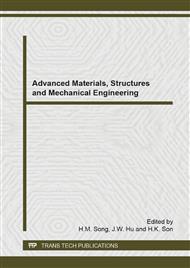p.274
p.278
p.283
p.288
p.292
p.298
p.302
p.310
p.317
Effect of Linear Sliding Speed on Wear Behavior of Al2O3/TiC Ceramic Composite and Diamond Slicing Blade
Abstract:
Pin-on-disk technique was used as a tool to study the tribological properties of contacting surfaces of alumina-titanium carbide composite material and diamond slicing blade. Conditions for testing are linear sliding speed between 0.2 and 0.4 m/s under applied load of 10 N and sliding distance up to 5000 m. The physical properties of both specimens which are mass loss, surface roughness and morphology of worn surface are investigated. The effect of linear sliding speed is analyzed in term of friction coefficient, surface roughness, and specific wear rate. It was found that, at initial state of wear, when sliding distant is less than 1000 m, the wear is severe, as seen by high values of specific wear rate and large fluctuation of friction coefficient. Worn surface of AlTiC is rougher than as-received condition. For a longer sliding distant, milder abrasion is found, as seen by the lower specific wear rate, and less fluctuation of friction coefficient, which produces worn AlTiC surface which is smoother than the as-received condition.
Info:
Periodical:
Pages:
292-297
Citation:
Online since:
September 2014
Keywords:
Price:
Сopyright:
© 2014 Trans Tech Publications Ltd. All Rights Reserved
Share:
Citation:


